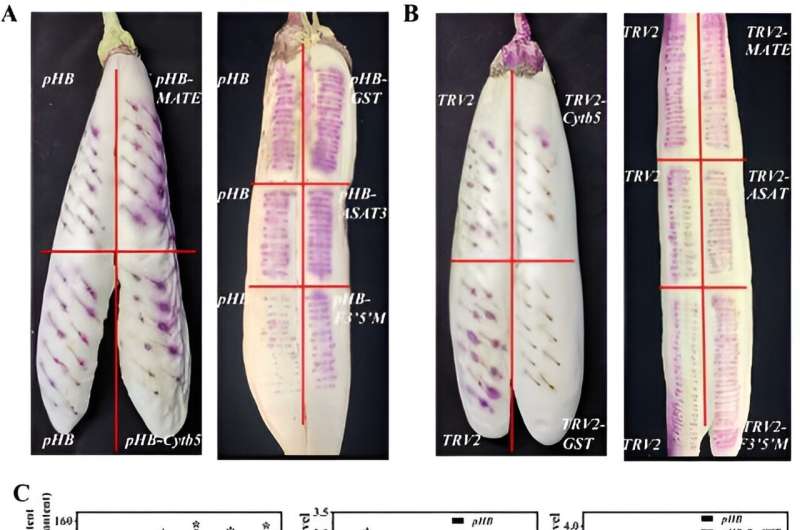This article has been reviewed according to Science X's editorial process and policies. Editors have highlighted the following attributes while ensuring the content's credibility:
fact-checked
trusted source
proofread
RNA-sequencing analysis reveals key genes behind eggplant peel variation

Anthocyanins give fruits and vegetables their red, purple, and blue colors, offering health benefits. Their biosynthesis involves specific enzymes and is regulated by the MBW complex of transcription factors. Research has linked color variations in plants to anthocyanin content and structure, with transcriptomic analyses revealing genes involved in these differences.
In eggplants, SmMYB113 has been identified as a key regulator of anthocyanin biosynthesis, affecting peel color. Despite progress, the precise molecular mechanisms behind color diversity in eggplants remain unclear, indicating a need for further investigation into anthocyanin biosynthesis and regulation.
Horticulture Research published research titled "RNA-sequencing analysis reveals novel genes involved in the different peel color formation in eggplant."
Firstly, the expression patterns of anthocyanin biosynthesis genes in eggplants of different colors and developmental stages were explored, and it was found that anthocyanin biosynthesis genes were more expressed in purple eggplant varieties, especially in the rapid growth stage.
RNA seq analysis was performed on the G-stage eggplant skin to identify differentially expressed genes (DEGs) related to anthocyanin and flavonoid biosynthesis. Particularly, specific genes, including SmMYB113 and WRKY44, were up-regulated in cultivars with higher delphinidin/flavonoid ratios, suggesting their involvement in color variation. Furthermore, the study uncovered 27 novel genes potentially linked to color differences and 32 novel genes within the SmMYB113-regulated anthocyanin biosynthesis network.
Notably, five genes (SmCytb5, SmGST, SmMATE, SmASAT3, and SmF3'5'M) were identified as crucial for both color variation and anthocyanin accumulation. The expression of these five genes was directly activated by SmMYB113 through yeast one-hybrid, electrophoretic mobility shift assay, and dual luciferase experiments.
Overall, the research not only elucidates the transcriptional basis of color variation in eggplant peels but also highlights SmMYB113's central role in regulating anthocyanin biosynthesis, offering insights for future genetic and breeding strategies to enhance fruit coloration.
More information: Jing Li et al, RNA-sequencing analysis reveals novel genes involved in the different peel color formation in eggplant, Horticulture Research (2023). DOI: 10.1093/hr/uhad181
Provided by NanJing Agricultural University



















